Critical Analysis: Osteocalcin as the Bone-Muscle Influence Mechanism
VerifiedAdded on 2023/06/13
|9
|2597
|463
Essay
AI Summary
This essay critically examines the statement that osteocalcin is the mechanism by which bones influence muscle function. It begins by introducing osteocalcin as a vitamin K-dependent protein hormone produced by osteoblasts, highlighting its role in bone health and its effects on adipose tissue and pancreatic beta cells. The essay discusses the impact of both low and high osteocalcin levels, linking low levels to diabetes, heart disease, and obesity, and high levels to osteoporosis and gestational diabetes. It also presents evidence supporting the claim that osteocalcin influences muscle function, citing research on mice and humans demonstrating that osteocalcin enhances exercise capacity and muscle performance. The essay concludes by affirming the significant impact of osteocalcin on muscle function, referencing studies that show how osteocalcin helps muscles uptake and break down glucose and fatty acids for energy during exercise. For more study resources and solved assignments, visit Desklib.

[COMPANY NAME] [Company address]
[DOCUMENT TITLE]
[DOCUMENT TITLE]
Paraphrase This Document
Need a fresh take? Get an instant paraphrase of this document with our AI Paraphraser
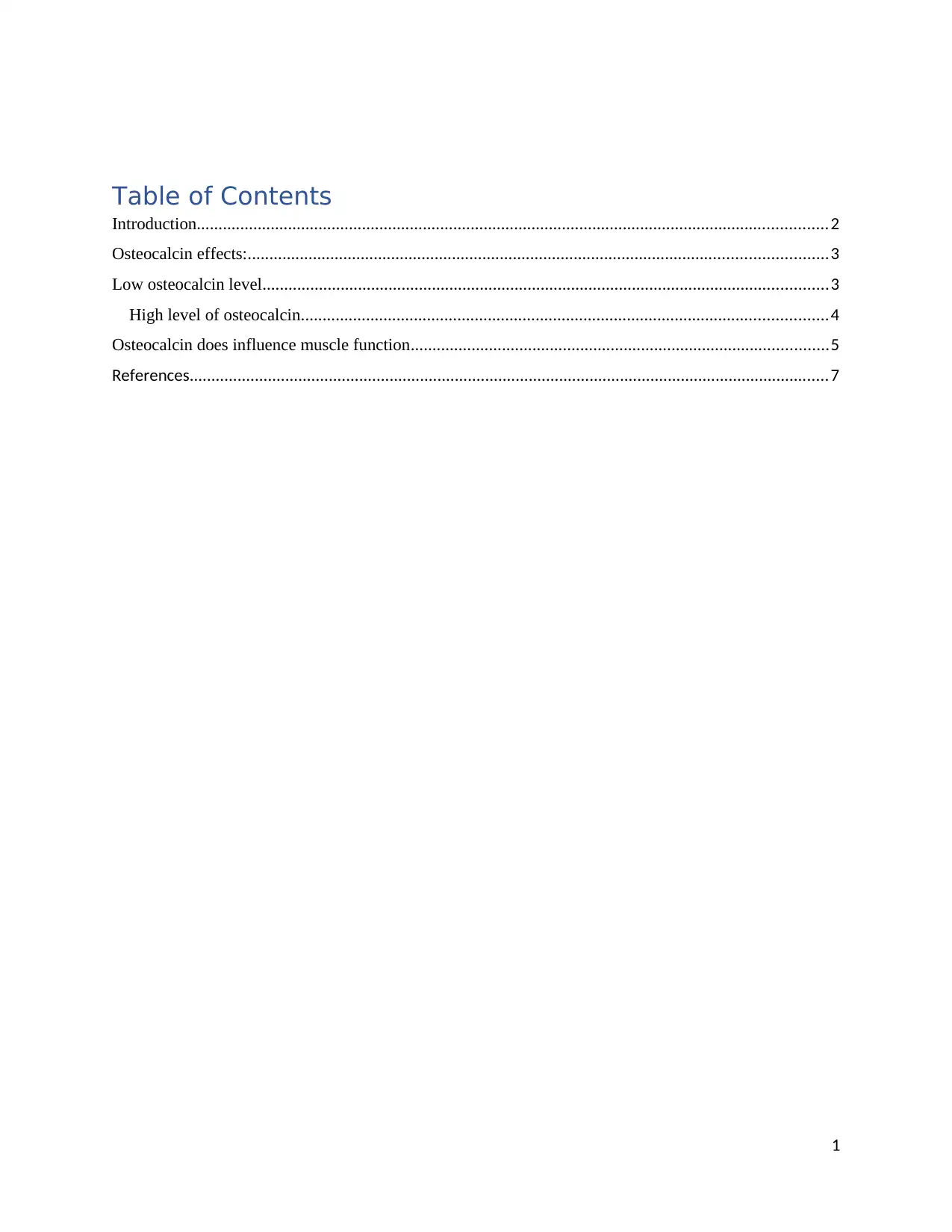
Table of Contents
Introduction.................................................................................................................................................2
Osteocalcin effects:.....................................................................................................................................3
Low osteocalcin level..................................................................................................................................3
High level of osteocalcin.........................................................................................................................4
Osteocalcin does influence muscle function................................................................................................5
References...................................................................................................................................................7
1
Introduction.................................................................................................................................................2
Osteocalcin effects:.....................................................................................................................................3
Low osteocalcin level..................................................................................................................................3
High level of osteocalcin.........................................................................................................................4
Osteocalcin does influence muscle function................................................................................................5
References...................................................................................................................................................7
1
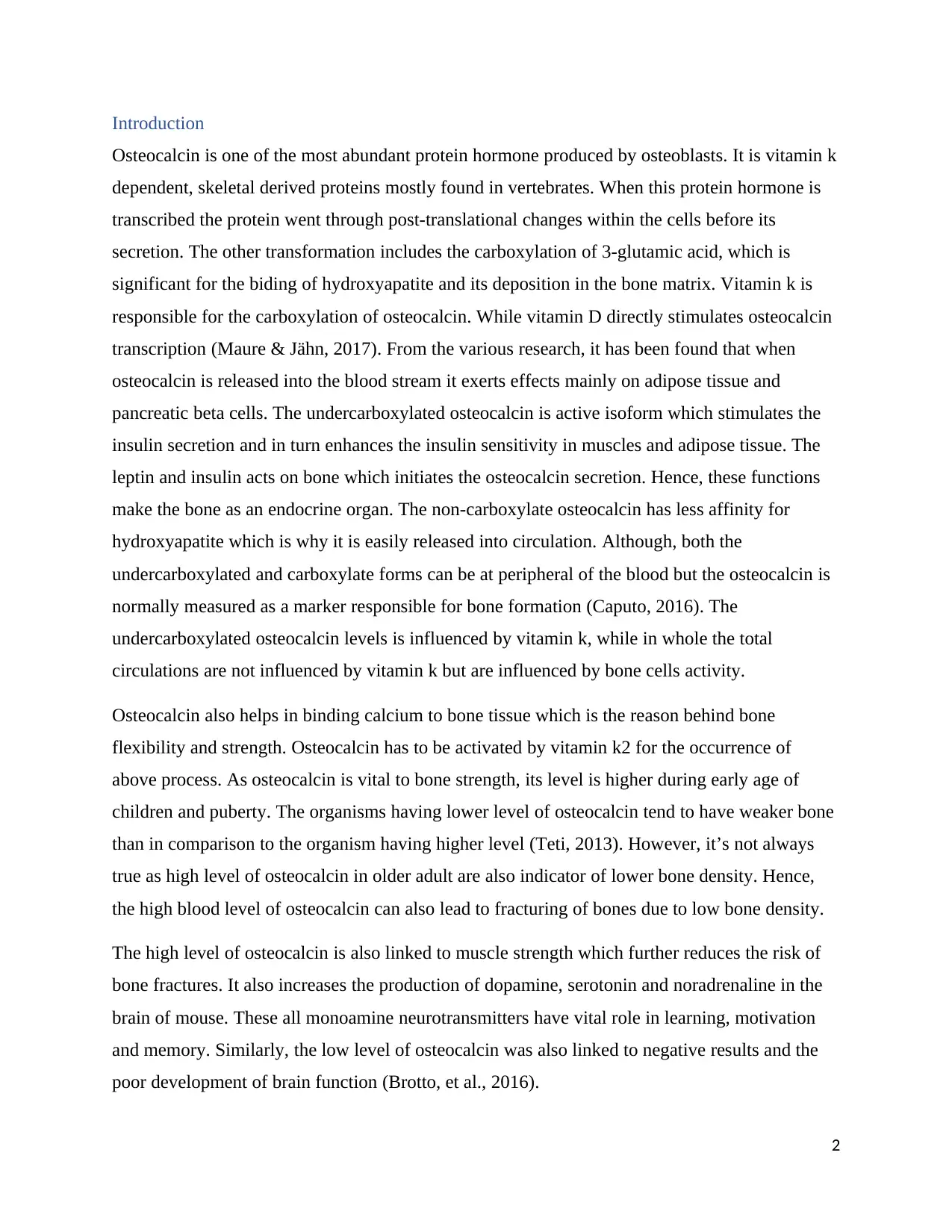
Introduction
Osteocalcin is one of the most abundant protein hormone produced by osteoblasts. It is vitamin k
dependent, skeletal derived proteins mostly found in vertebrates. When this protein hormone is
transcribed the protein went through post-translational changes within the cells before its
secretion. The other transformation includes the carboxylation of 3-glutamic acid, which is
significant for the biding of hydroxyapatite and its deposition in the bone matrix. Vitamin k is
responsible for the carboxylation of osteocalcin. While vitamin D directly stimulates osteocalcin
transcription (Maure & Jähn, 2017). From the various research, it has been found that when
osteocalcin is released into the blood stream it exerts effects mainly on adipose tissue and
pancreatic beta cells. The undercarboxylated osteocalcin is active isoform which stimulates the
insulin secretion and in turn enhances the insulin sensitivity in muscles and adipose tissue. The
leptin and insulin acts on bone which initiates the osteocalcin secretion. Hence, these functions
make the bone as an endocrine organ. The non-carboxylate osteocalcin has less affinity for
hydroxyapatite which is why it is easily released into circulation. Although, both the
undercarboxylated and carboxylate forms can be at peripheral of the blood but the osteocalcin is
normally measured as a marker responsible for bone formation (Caputo, 2016). The
undercarboxylated osteocalcin levels is influenced by vitamin k, while in whole the total
circulations are not influenced by vitamin k but are influenced by bone cells activity.
Osteocalcin also helps in binding calcium to bone tissue which is the reason behind bone
flexibility and strength. Osteocalcin has to be activated by vitamin k2 for the occurrence of
above process. As osteocalcin is vital to bone strength, its level is higher during early age of
children and puberty. The organisms having lower level of osteocalcin tend to have weaker bone
than in comparison to the organism having higher level (Teti, 2013). However, it’s not always
true as high level of osteocalcin in older adult are also indicator of lower bone density. Hence,
the high blood level of osteocalcin can also lead to fracturing of bones due to low bone density.
The high level of osteocalcin is also linked to muscle strength which further reduces the risk of
bone fractures. It also increases the production of dopamine, serotonin and noradrenaline in the
brain of mouse. These all monoamine neurotransmitters have vital role in learning, motivation
and memory. Similarly, the low level of osteocalcin was also linked to negative results and the
poor development of brain function (Brotto, et al., 2016).
2
Osteocalcin is one of the most abundant protein hormone produced by osteoblasts. It is vitamin k
dependent, skeletal derived proteins mostly found in vertebrates. When this protein hormone is
transcribed the protein went through post-translational changes within the cells before its
secretion. The other transformation includes the carboxylation of 3-glutamic acid, which is
significant for the biding of hydroxyapatite and its deposition in the bone matrix. Vitamin k is
responsible for the carboxylation of osteocalcin. While vitamin D directly stimulates osteocalcin
transcription (Maure & Jähn, 2017). From the various research, it has been found that when
osteocalcin is released into the blood stream it exerts effects mainly on adipose tissue and
pancreatic beta cells. The undercarboxylated osteocalcin is active isoform which stimulates the
insulin secretion and in turn enhances the insulin sensitivity in muscles and adipose tissue. The
leptin and insulin acts on bone which initiates the osteocalcin secretion. Hence, these functions
make the bone as an endocrine organ. The non-carboxylate osteocalcin has less affinity for
hydroxyapatite which is why it is easily released into circulation. Although, both the
undercarboxylated and carboxylate forms can be at peripheral of the blood but the osteocalcin is
normally measured as a marker responsible for bone formation (Caputo, 2016). The
undercarboxylated osteocalcin levels is influenced by vitamin k, while in whole the total
circulations are not influenced by vitamin k but are influenced by bone cells activity.
Osteocalcin also helps in binding calcium to bone tissue which is the reason behind bone
flexibility and strength. Osteocalcin has to be activated by vitamin k2 for the occurrence of
above process. As osteocalcin is vital to bone strength, its level is higher during early age of
children and puberty. The organisms having lower level of osteocalcin tend to have weaker bone
than in comparison to the organism having higher level (Teti, 2013). However, it’s not always
true as high level of osteocalcin in older adult are also indicator of lower bone density. Hence,
the high blood level of osteocalcin can also lead to fracturing of bones due to low bone density.
The high level of osteocalcin is also linked to muscle strength which further reduces the risk of
bone fractures. It also increases the production of dopamine, serotonin and noradrenaline in the
brain of mouse. These all monoamine neurotransmitters have vital role in learning, motivation
and memory. Similarly, the low level of osteocalcin was also linked to negative results and the
poor development of brain function (Brotto, et al., 2016).
2
⊘ This is a preview!⊘
Do you want full access?
Subscribe today to unlock all pages.

Trusted by 1+ million students worldwide
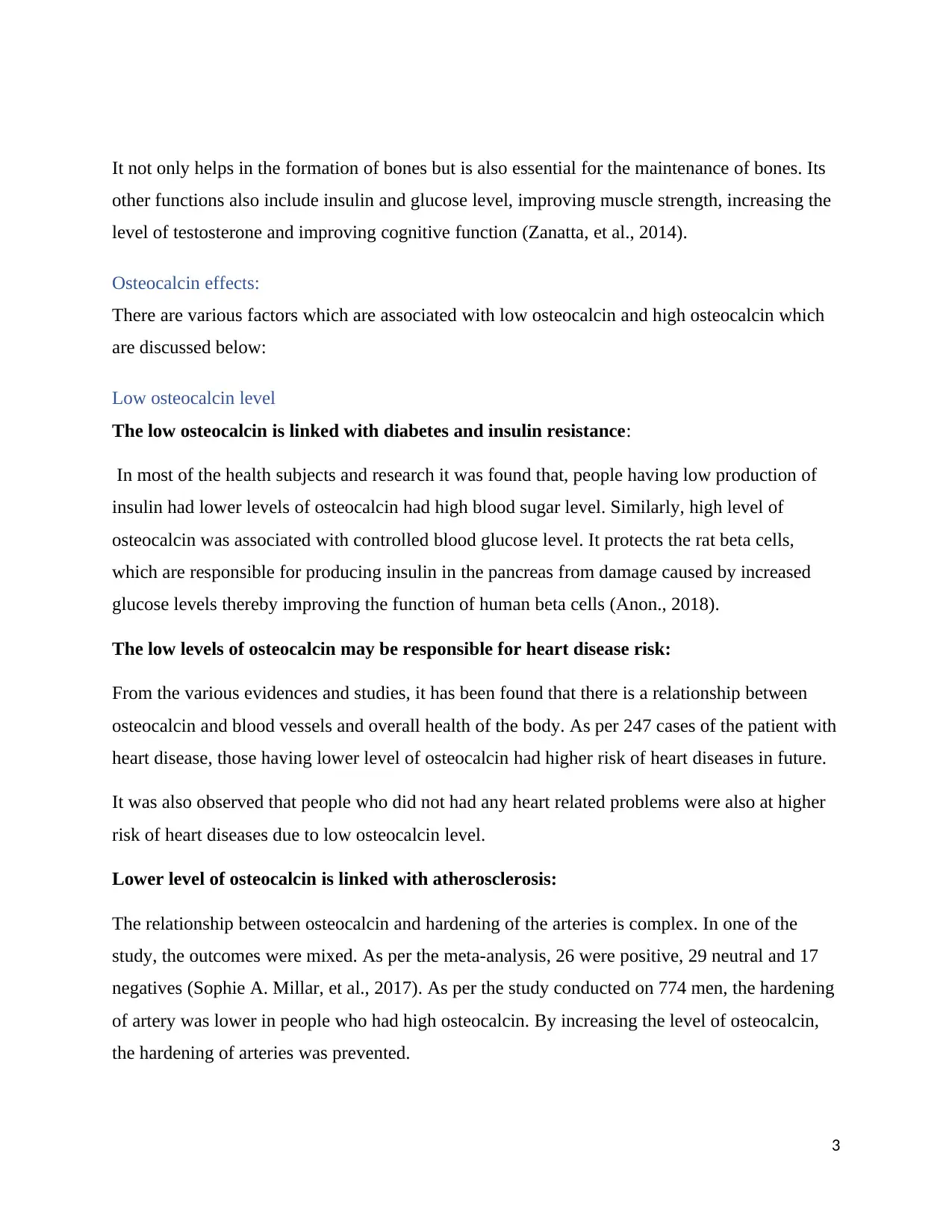
It not only helps in the formation of bones but is also essential for the maintenance of bones. Its
other functions also include insulin and glucose level, improving muscle strength, increasing the
level of testosterone and improving cognitive function (Zanatta, et al., 2014).
Osteocalcin effects:
There are various factors which are associated with low osteocalcin and high osteocalcin which
are discussed below:
Low osteocalcin level
The low osteocalcin is linked with diabetes and insulin resistance:
In most of the health subjects and research it was found that, people having low production of
insulin had lower levels of osteocalcin had high blood sugar level. Similarly, high level of
osteocalcin was associated with controlled blood glucose level. It protects the rat beta cells,
which are responsible for producing insulin in the pancreas from damage caused by increased
glucose levels thereby improving the function of human beta cells (Anon., 2018).
The low levels of osteocalcin may be responsible for heart disease risk:
From the various evidences and studies, it has been found that there is a relationship between
osteocalcin and blood vessels and overall health of the body. As per 247 cases of the patient with
heart disease, those having lower level of osteocalcin had higher risk of heart diseases in future.
It was also observed that people who did not had any heart related problems were also at higher
risk of heart diseases due to low osteocalcin level.
Lower level of osteocalcin is linked with atherosclerosis:
The relationship between osteocalcin and hardening of the arteries is complex. In one of the
study, the outcomes were mixed. As per the meta-analysis, 26 were positive, 29 neutral and 17
negatives (Sophie A. Millar, et al., 2017). As per the study conducted on 774 men, the hardening
of artery was lower in people who had high osteocalcin. By increasing the level of osteocalcin,
the hardening of arteries was prevented.
3
other functions also include insulin and glucose level, improving muscle strength, increasing the
level of testosterone and improving cognitive function (Zanatta, et al., 2014).
Osteocalcin effects:
There are various factors which are associated with low osteocalcin and high osteocalcin which
are discussed below:
Low osteocalcin level
The low osteocalcin is linked with diabetes and insulin resistance:
In most of the health subjects and research it was found that, people having low production of
insulin had lower levels of osteocalcin had high blood sugar level. Similarly, high level of
osteocalcin was associated with controlled blood glucose level. It protects the rat beta cells,
which are responsible for producing insulin in the pancreas from damage caused by increased
glucose levels thereby improving the function of human beta cells (Anon., 2018).
The low levels of osteocalcin may be responsible for heart disease risk:
From the various evidences and studies, it has been found that there is a relationship between
osteocalcin and blood vessels and overall health of the body. As per 247 cases of the patient with
heart disease, those having lower level of osteocalcin had higher risk of heart diseases in future.
It was also observed that people who did not had any heart related problems were also at higher
risk of heart diseases due to low osteocalcin level.
Lower level of osteocalcin is linked with atherosclerosis:
The relationship between osteocalcin and hardening of the arteries is complex. In one of the
study, the outcomes were mixed. As per the meta-analysis, 26 were positive, 29 neutral and 17
negatives (Sophie A. Millar, et al., 2017). As per the study conducted on 774 men, the hardening
of artery was lower in people who had high osteocalcin. By increasing the level of osteocalcin,
the hardening of arteries was prevented.
3
Paraphrase This Document
Need a fresh take? Get an instant paraphrase of this document with our AI Paraphraser
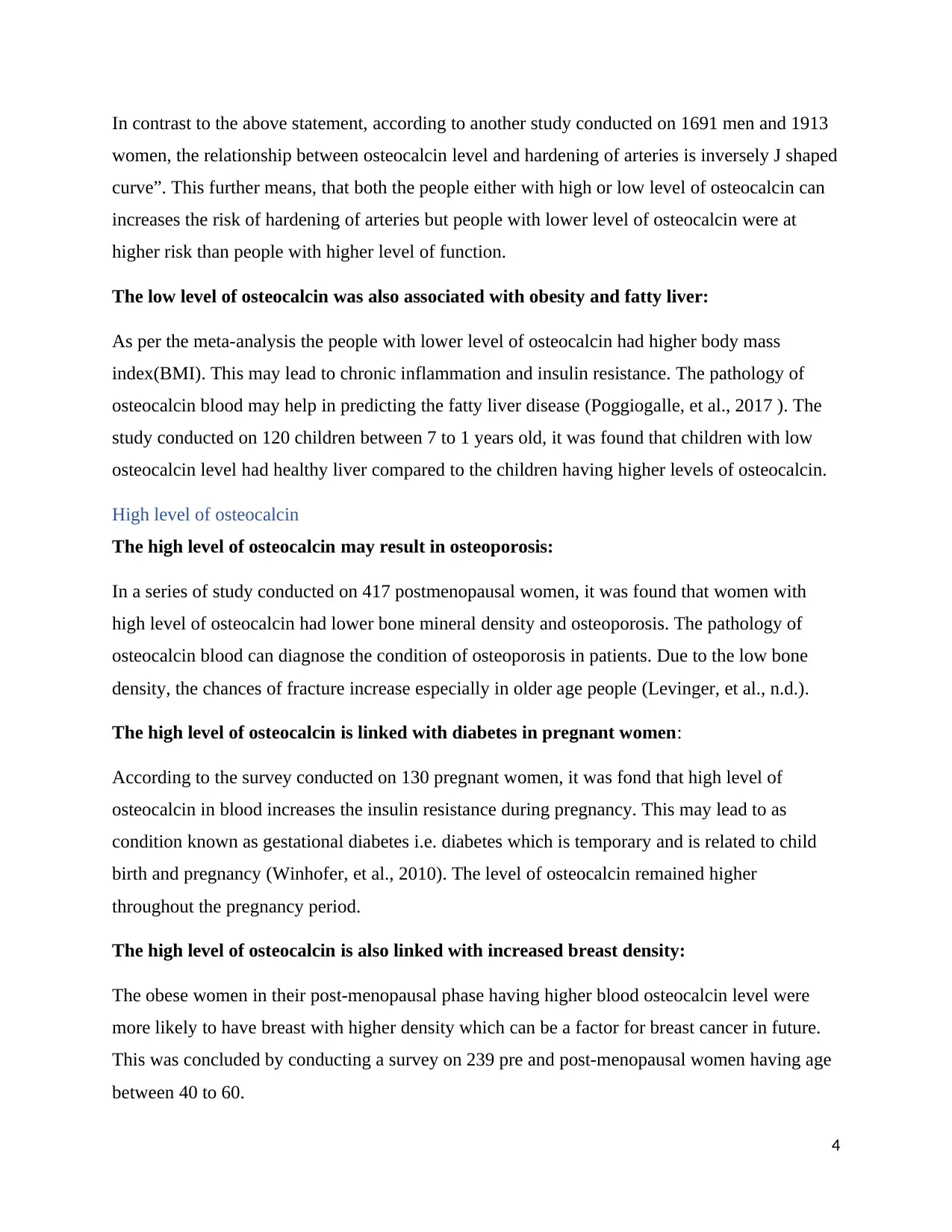
In contrast to the above statement, according to another study conducted on 1691 men and 1913
women, the relationship between osteocalcin level and hardening of arteries is inversely J shaped
curve”. This further means, that both the people either with high or low level of osteocalcin can
increases the risk of hardening of arteries but people with lower level of osteocalcin were at
higher risk than people with higher level of function.
The low level of osteocalcin was also associated with obesity and fatty liver:
As per the meta-analysis the people with lower level of osteocalcin had higher body mass
index(BMI). This may lead to chronic inflammation and insulin resistance. The pathology of
osteocalcin blood may help in predicting the fatty liver disease (Poggiogalle, et al., 2017 ). The
study conducted on 120 children between 7 to 1 years old, it was found that children with low
osteocalcin level had healthy liver compared to the children having higher levels of osteocalcin.
High level of osteocalcin
The high level of osteocalcin may result in osteoporosis:
In a series of study conducted on 417 postmenopausal women, it was found that women with
high level of osteocalcin had lower bone mineral density and osteoporosis. The pathology of
osteocalcin blood can diagnose the condition of osteoporosis in patients. Due to the low bone
density, the chances of fracture increase especially in older age people (Levinger, et al., n.d.).
The high level of osteocalcin is linked with diabetes in pregnant women:
According to the survey conducted on 130 pregnant women, it was fond that high level of
osteocalcin in blood increases the insulin resistance during pregnancy. This may lead to as
condition known as gestational diabetes i.e. diabetes which is temporary and is related to child
birth and pregnancy (Winhofer, et al., 2010). The level of osteocalcin remained higher
throughout the pregnancy period.
The high level of osteocalcin is also linked with increased breast density:
The obese women in their post-menopausal phase having higher blood osteocalcin level were
more likely to have breast with higher density which can be a factor for breast cancer in future.
This was concluded by conducting a survey on 239 pre and post-menopausal women having age
between 40 to 60.
4
women, the relationship between osteocalcin level and hardening of arteries is inversely J shaped
curve”. This further means, that both the people either with high or low level of osteocalcin can
increases the risk of hardening of arteries but people with lower level of osteocalcin were at
higher risk than people with higher level of function.
The low level of osteocalcin was also associated with obesity and fatty liver:
As per the meta-analysis the people with lower level of osteocalcin had higher body mass
index(BMI). This may lead to chronic inflammation and insulin resistance. The pathology of
osteocalcin blood may help in predicting the fatty liver disease (Poggiogalle, et al., 2017 ). The
study conducted on 120 children between 7 to 1 years old, it was found that children with low
osteocalcin level had healthy liver compared to the children having higher levels of osteocalcin.
High level of osteocalcin
The high level of osteocalcin may result in osteoporosis:
In a series of study conducted on 417 postmenopausal women, it was found that women with
high level of osteocalcin had lower bone mineral density and osteoporosis. The pathology of
osteocalcin blood can diagnose the condition of osteoporosis in patients. Due to the low bone
density, the chances of fracture increase especially in older age people (Levinger, et al., n.d.).
The high level of osteocalcin is linked with diabetes in pregnant women:
According to the survey conducted on 130 pregnant women, it was fond that high level of
osteocalcin in blood increases the insulin resistance during pregnancy. This may lead to as
condition known as gestational diabetes i.e. diabetes which is temporary and is related to child
birth and pregnancy (Winhofer, et al., 2010). The level of osteocalcin remained higher
throughout the pregnancy period.
The high level of osteocalcin is also linked with increased breast density:
The obese women in their post-menopausal phase having higher blood osteocalcin level were
more likely to have breast with higher density which can be a factor for breast cancer in future.
This was concluded by conducting a survey on 239 pre and post-menopausal women having age
between 40 to 60.
4
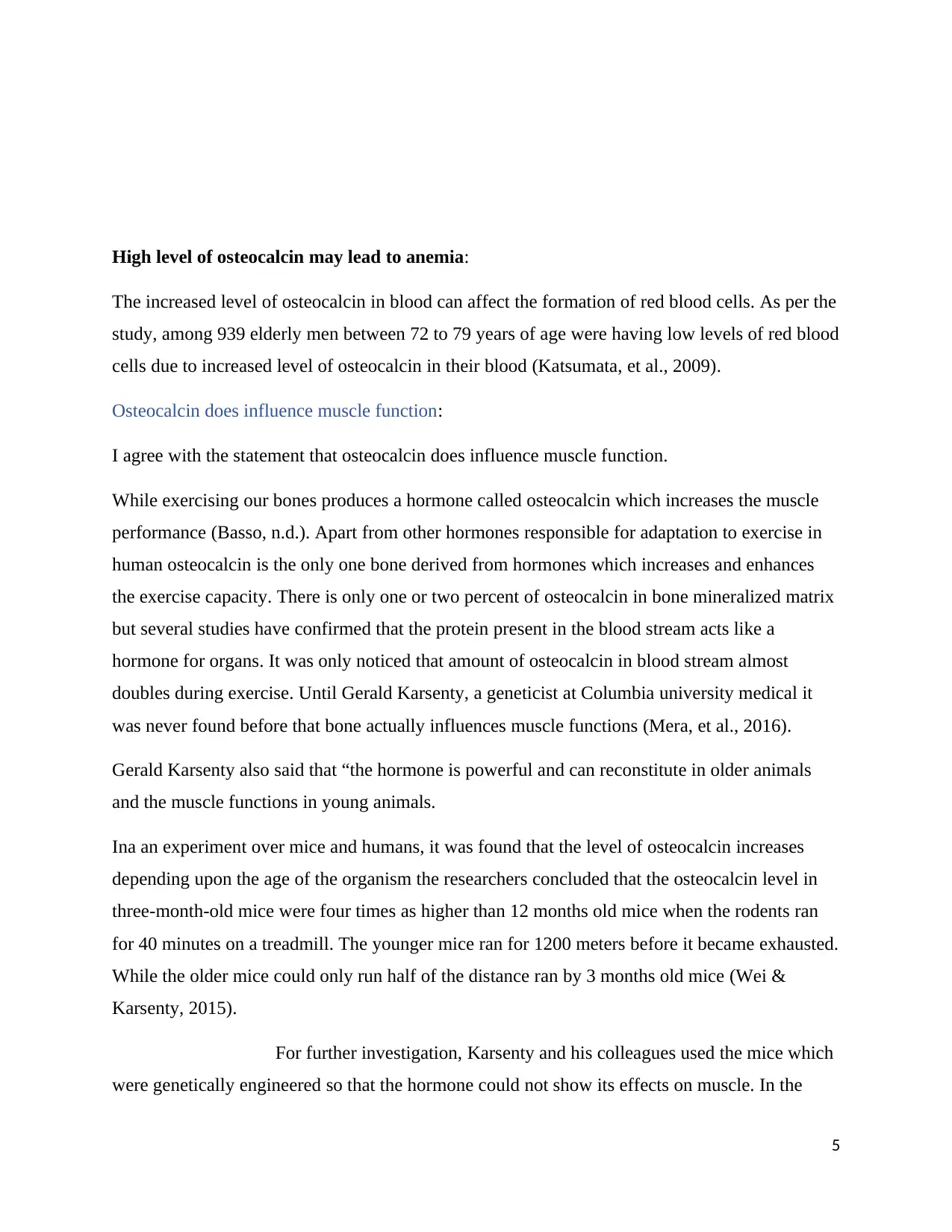
High level of osteocalcin may lead to anemia:
The increased level of osteocalcin in blood can affect the formation of red blood cells. As per the
study, among 939 elderly men between 72 to 79 years of age were having low levels of red blood
cells due to increased level of osteocalcin in their blood (Katsumata, et al., 2009).
Osteocalcin does influence muscle function:
I agree with the statement that osteocalcin does influence muscle function.
While exercising our bones produces a hormone called osteocalcin which increases the muscle
performance (Basso, n.d.). Apart from other hormones responsible for adaptation to exercise in
human osteocalcin is the only one bone derived from hormones which increases and enhances
the exercise capacity. There is only one or two percent of osteocalcin in bone mineralized matrix
but several studies have confirmed that the protein present in the blood stream acts like a
hormone for organs. It was only noticed that amount of osteocalcin in blood stream almost
doubles during exercise. Until Gerald Karsenty, a geneticist at Columbia university medical it
was never found before that bone actually influences muscle functions (Mera, et al., 2016).
Gerald Karsenty also said that “the hormone is powerful and can reconstitute in older animals
and the muscle functions in young animals.
Ina an experiment over mice and humans, it was found that the level of osteocalcin increases
depending upon the age of the organism the researchers concluded that the osteocalcin level in
three-month-old mice were four times as higher than 12 months old mice when the rodents ran
for 40 minutes on a treadmill. The younger mice ran for 1200 meters before it became exhausted.
While the older mice could only run half of the distance ran by 3 months old mice (Wei &
Karsenty, 2015).
For further investigation, Karsenty and his colleagues used the mice which
were genetically engineered so that the hormone could not show its effects on muscle. In the
5
The increased level of osteocalcin in blood can affect the formation of red blood cells. As per the
study, among 939 elderly men between 72 to 79 years of age were having low levels of red blood
cells due to increased level of osteocalcin in their blood (Katsumata, et al., 2009).
Osteocalcin does influence muscle function:
I agree with the statement that osteocalcin does influence muscle function.
While exercising our bones produces a hormone called osteocalcin which increases the muscle
performance (Basso, n.d.). Apart from other hormones responsible for adaptation to exercise in
human osteocalcin is the only one bone derived from hormones which increases and enhances
the exercise capacity. There is only one or two percent of osteocalcin in bone mineralized matrix
but several studies have confirmed that the protein present in the blood stream acts like a
hormone for organs. It was only noticed that amount of osteocalcin in blood stream almost
doubles during exercise. Until Gerald Karsenty, a geneticist at Columbia university medical it
was never found before that bone actually influences muscle functions (Mera, et al., 2016).
Gerald Karsenty also said that “the hormone is powerful and can reconstitute in older animals
and the muscle functions in young animals.
Ina an experiment over mice and humans, it was found that the level of osteocalcin increases
depending upon the age of the organism the researchers concluded that the osteocalcin level in
three-month-old mice were four times as higher than 12 months old mice when the rodents ran
for 40 minutes on a treadmill. The younger mice ran for 1200 meters before it became exhausted.
While the older mice could only run half of the distance ran by 3 months old mice (Wei &
Karsenty, 2015).
For further investigation, Karsenty and his colleagues used the mice which
were genetically engineered so that the hormone could not show its effects on muscle. In the
5
⊘ This is a preview!⊘
Do you want full access?
Subscribe today to unlock all pages.

Trusted by 1+ million students worldwide
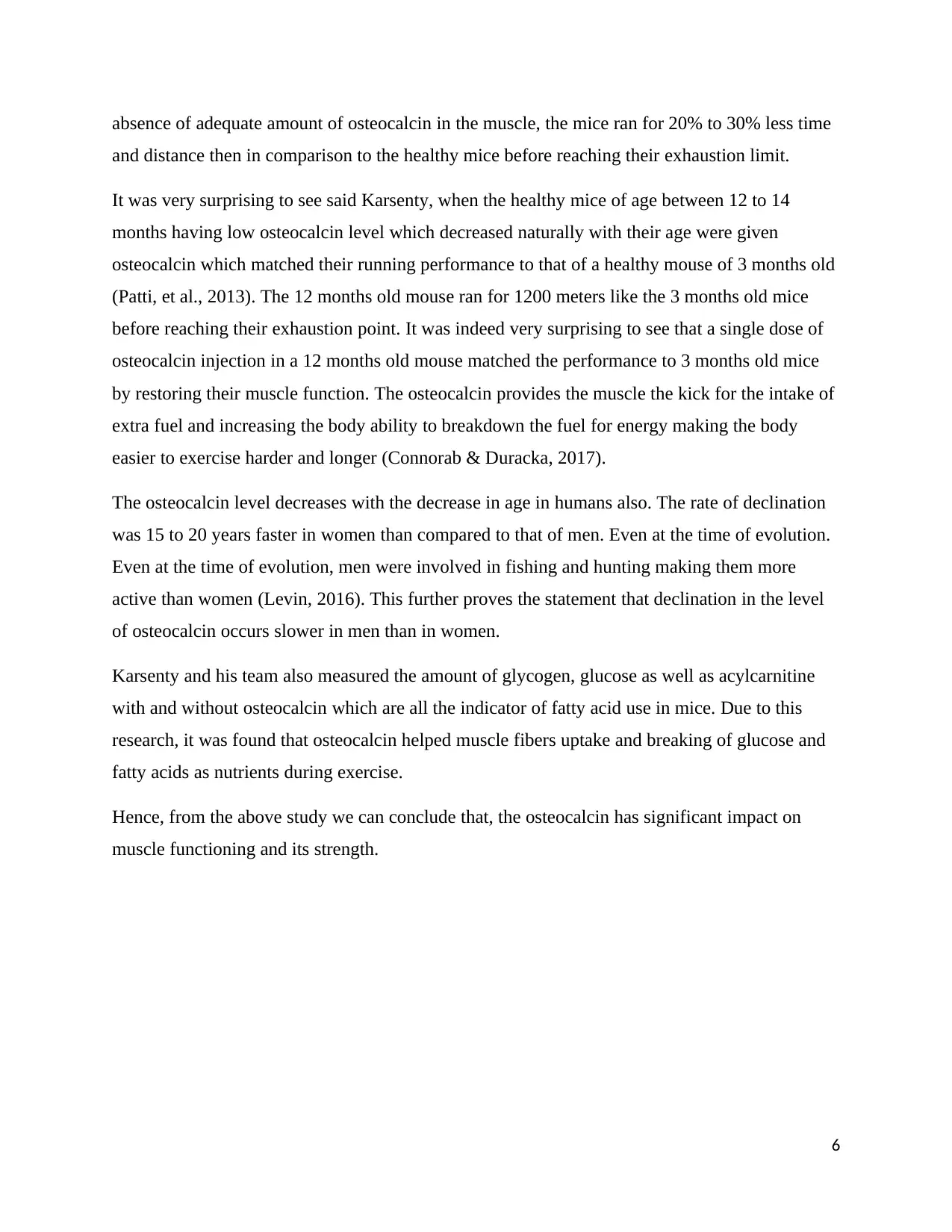
absence of adequate amount of osteocalcin in the muscle, the mice ran for 20% to 30% less time
and distance then in comparison to the healthy mice before reaching their exhaustion limit.
It was very surprising to see said Karsenty, when the healthy mice of age between 12 to 14
months having low osteocalcin level which decreased naturally with their age were given
osteocalcin which matched their running performance to that of a healthy mouse of 3 months old
(Patti, et al., 2013). The 12 months old mouse ran for 1200 meters like the 3 months old mice
before reaching their exhaustion point. It was indeed very surprising to see that a single dose of
osteocalcin injection in a 12 months old mouse matched the performance to 3 months old mice
by restoring their muscle function. The osteocalcin provides the muscle the kick for the intake of
extra fuel and increasing the body ability to breakdown the fuel for energy making the body
easier to exercise harder and longer (Connorab & Duracka, 2017).
The osteocalcin level decreases with the decrease in age in humans also. The rate of declination
was 15 to 20 years faster in women than compared to that of men. Even at the time of evolution.
Even at the time of evolution, men were involved in fishing and hunting making them more
active than women (Levin, 2016). This further proves the statement that declination in the level
of osteocalcin occurs slower in men than in women.
Karsenty and his team also measured the amount of glycogen, glucose as well as acylcarnitine
with and without osteocalcin which are all the indicator of fatty acid use in mice. Due to this
research, it was found that osteocalcin helped muscle fibers uptake and breaking of glucose and
fatty acids as nutrients during exercise.
Hence, from the above study we can conclude that, the osteocalcin has significant impact on
muscle functioning and its strength.
6
and distance then in comparison to the healthy mice before reaching their exhaustion limit.
It was very surprising to see said Karsenty, when the healthy mice of age between 12 to 14
months having low osteocalcin level which decreased naturally with their age were given
osteocalcin which matched their running performance to that of a healthy mouse of 3 months old
(Patti, et al., 2013). The 12 months old mouse ran for 1200 meters like the 3 months old mice
before reaching their exhaustion point. It was indeed very surprising to see that a single dose of
osteocalcin injection in a 12 months old mouse matched the performance to 3 months old mice
by restoring their muscle function. The osteocalcin provides the muscle the kick for the intake of
extra fuel and increasing the body ability to breakdown the fuel for energy making the body
easier to exercise harder and longer (Connorab & Duracka, 2017).
The osteocalcin level decreases with the decrease in age in humans also. The rate of declination
was 15 to 20 years faster in women than compared to that of men. Even at the time of evolution.
Even at the time of evolution, men were involved in fishing and hunting making them more
active than women (Levin, 2016). This further proves the statement that declination in the level
of osteocalcin occurs slower in men than in women.
Karsenty and his team also measured the amount of glycogen, glucose as well as acylcarnitine
with and without osteocalcin which are all the indicator of fatty acid use in mice. Due to this
research, it was found that osteocalcin helped muscle fibers uptake and breaking of glucose and
fatty acids as nutrients during exercise.
Hence, from the above study we can conclude that, the osteocalcin has significant impact on
muscle functioning and its strength.
6
Paraphrase This Document
Need a fresh take? Get an instant paraphrase of this document with our AI Paraphraser
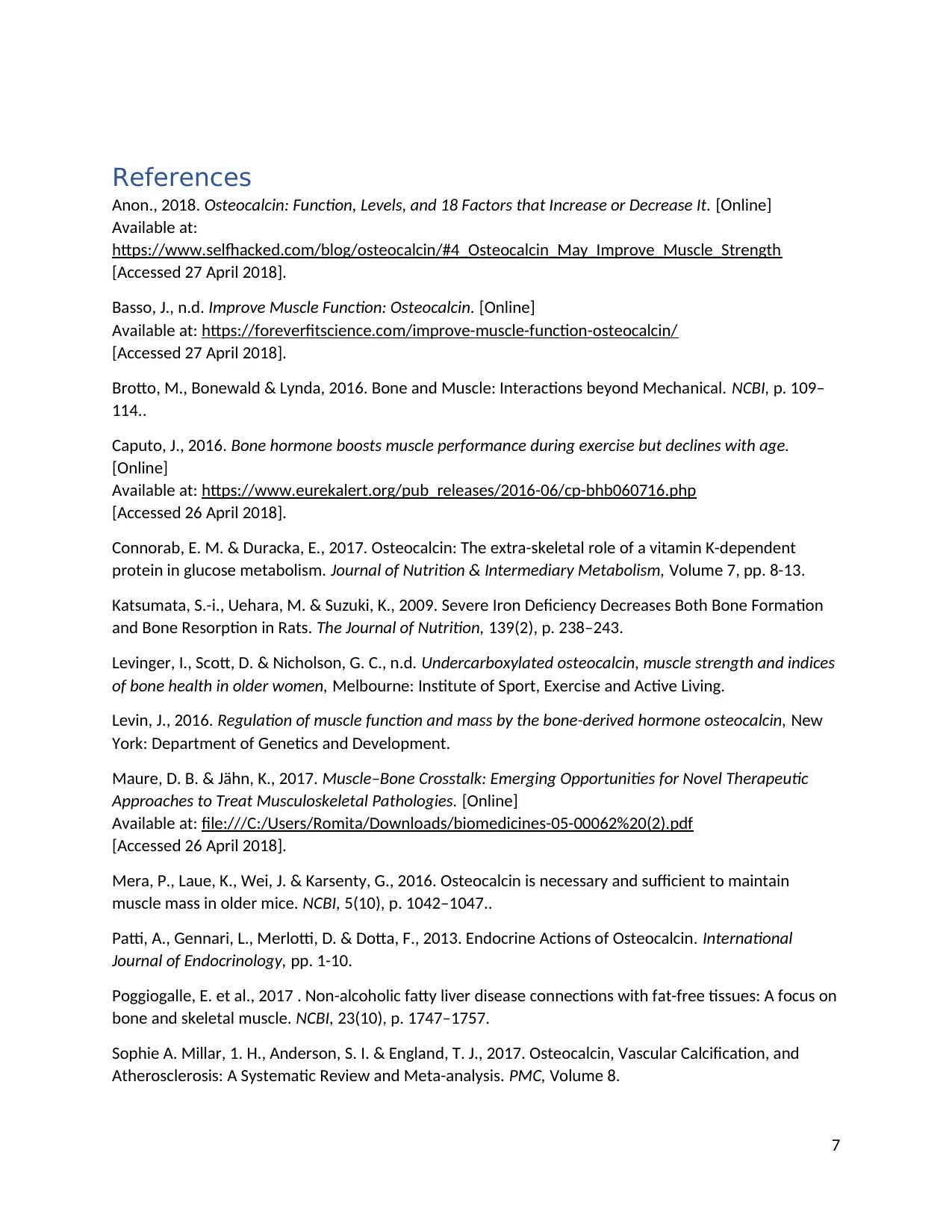
References
Anon., 2018. Osteocalcin: Function, Levels, and 18 Factors that Increase or Decrease It. [Online]
Available at:
https://www.selfhacked.com/blog/osteocalcin/#4_Osteocalcin_May_Improve_Muscle_Strength
[Accessed 27 April 2018].
Basso, J., n.d. Improve Muscle Function: Osteocalcin. [Online]
Available at: https://foreverfitscience.com/improve-muscle-function-osteocalcin/
[Accessed 27 April 2018].
Brotto, M., Bonewald & Lynda, 2016. Bone and Muscle: Interactions beyond Mechanical. NCBI, p. 109–
114..
Caputo, J., 2016. Bone hormone boosts muscle performance during exercise but declines with age.
[Online]
Available at: https://www.eurekalert.org/pub_releases/2016-06/cp-bhb060716.php
[Accessed 26 April 2018].
Connorab, E. M. & Duracka, E., 2017. Osteocalcin: The extra-skeletal role of a vitamin K-dependent
protein in glucose metabolism. Journal of Nutrition & Intermediary Metabolism, Volume 7, pp. 8-13.
Katsumata, S.-i., Uehara, M. & Suzuki, K., 2009. Severe Iron Deficiency Decreases Both Bone Formation
and Bone Resorption in Rats. The Journal of Nutrition, 139(2), p. 238–243.
Levinger, I., Scott, D. & Nicholson, G. C., n.d. Undercarboxylated osteocalcin, muscle strength and indices
of bone health in older women, Melbourne: Institute of Sport, Exercise and Active Living.
Levin, J., 2016. Regulation of muscle function and mass by the bone-derived hormone osteocalcin, New
York: Department of Genetics and Development.
Maure, D. B. & Jähn, K., 2017. Muscle–Bone Crosstalk: Emerging Opportunities for Novel Therapeutic
Approaches to Treat Musculoskeletal Pathologies. [Online]
Available at: file:///C:/Users/Romita/Downloads/biomedicines-05-00062%20(2).pdf
[Accessed 26 April 2018].
Mera, P., Laue, K., Wei, J. & Karsenty, G., 2016. Osteocalcin is necessary and sufficient to maintain
muscle mass in older mice. NCBI, 5(10), p. 1042–1047..
Patti, A., Gennari, L., Merlotti, D. & Dotta, F., 2013. Endocrine Actions of Osteocalcin. International
Journal of Endocrinology, pp. 1-10.
Poggiogalle, E. et al., 2017 . Non-alcoholic fatty liver disease connections with fat-free tissues: A focus on
bone and skeletal muscle. NCBI, 23(10), p. 1747–1757.
Sophie A. Millar, 1. H., Anderson, S. I. & England, T. J., 2017. Osteocalcin, Vascular Calcification, and
Atherosclerosis: A Systematic Review and Meta-analysis. PMC, Volume 8.
7
Anon., 2018. Osteocalcin: Function, Levels, and 18 Factors that Increase or Decrease It. [Online]
Available at:
https://www.selfhacked.com/blog/osteocalcin/#4_Osteocalcin_May_Improve_Muscle_Strength
[Accessed 27 April 2018].
Basso, J., n.d. Improve Muscle Function: Osteocalcin. [Online]
Available at: https://foreverfitscience.com/improve-muscle-function-osteocalcin/
[Accessed 27 April 2018].
Brotto, M., Bonewald & Lynda, 2016. Bone and Muscle: Interactions beyond Mechanical. NCBI, p. 109–
114..
Caputo, J., 2016. Bone hormone boosts muscle performance during exercise but declines with age.
[Online]
Available at: https://www.eurekalert.org/pub_releases/2016-06/cp-bhb060716.php
[Accessed 26 April 2018].
Connorab, E. M. & Duracka, E., 2017. Osteocalcin: The extra-skeletal role of a vitamin K-dependent
protein in glucose metabolism. Journal of Nutrition & Intermediary Metabolism, Volume 7, pp. 8-13.
Katsumata, S.-i., Uehara, M. & Suzuki, K., 2009. Severe Iron Deficiency Decreases Both Bone Formation
and Bone Resorption in Rats. The Journal of Nutrition, 139(2), p. 238–243.
Levinger, I., Scott, D. & Nicholson, G. C., n.d. Undercarboxylated osteocalcin, muscle strength and indices
of bone health in older women, Melbourne: Institute of Sport, Exercise and Active Living.
Levin, J., 2016. Regulation of muscle function and mass by the bone-derived hormone osteocalcin, New
York: Department of Genetics and Development.
Maure, D. B. & Jähn, K., 2017. Muscle–Bone Crosstalk: Emerging Opportunities for Novel Therapeutic
Approaches to Treat Musculoskeletal Pathologies. [Online]
Available at: file:///C:/Users/Romita/Downloads/biomedicines-05-00062%20(2).pdf
[Accessed 26 April 2018].
Mera, P., Laue, K., Wei, J. & Karsenty, G., 2016. Osteocalcin is necessary and sufficient to maintain
muscle mass in older mice. NCBI, 5(10), p. 1042–1047..
Patti, A., Gennari, L., Merlotti, D. & Dotta, F., 2013. Endocrine Actions of Osteocalcin. International
Journal of Endocrinology, pp. 1-10.
Poggiogalle, E. et al., 2017 . Non-alcoholic fatty liver disease connections with fat-free tissues: A focus on
bone and skeletal muscle. NCBI, 23(10), p. 1747–1757.
Sophie A. Millar, 1. H., Anderson, S. I. & England, T. J., 2017. Osteocalcin, Vascular Calcification, and
Atherosclerosis: A Systematic Review and Meta-analysis. PMC, Volume 8.
7
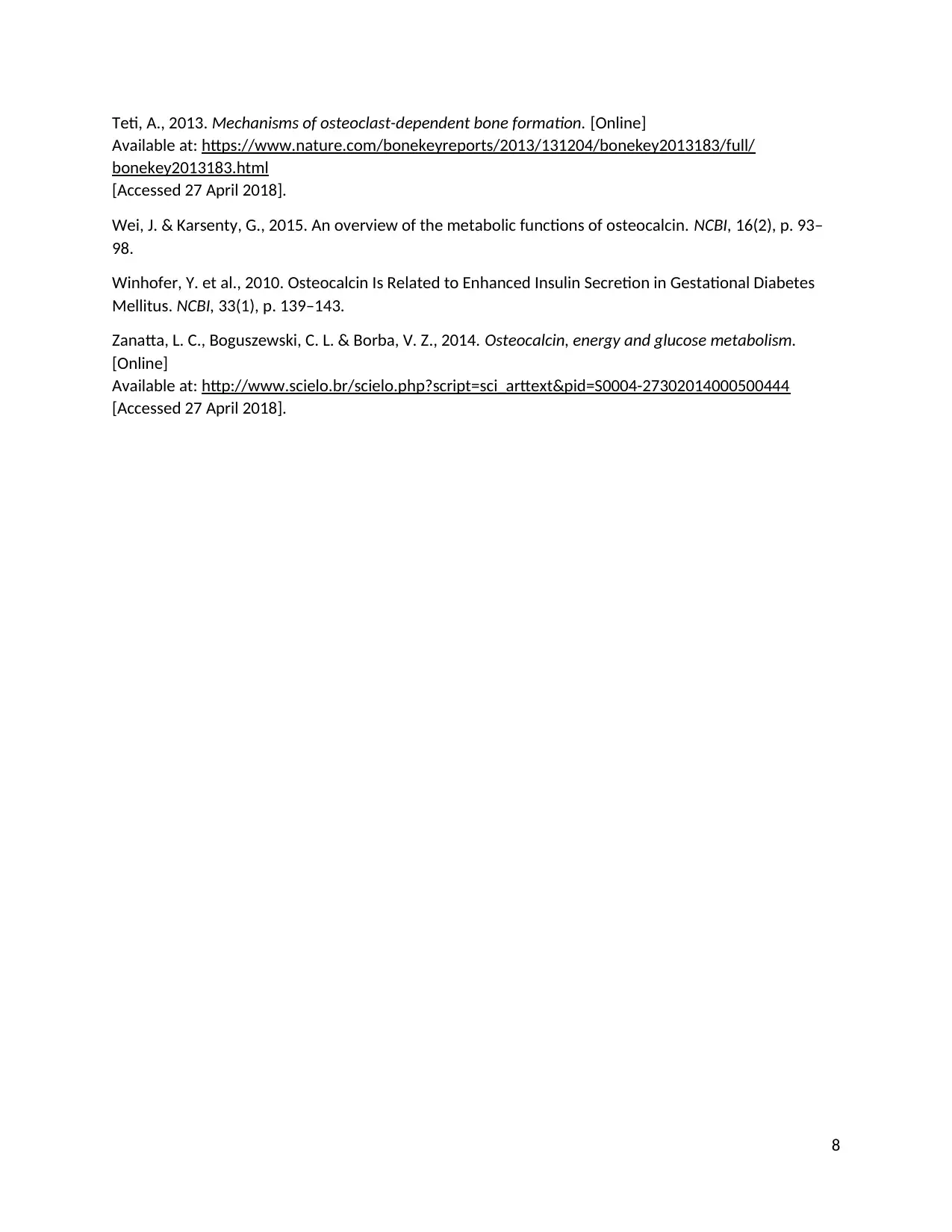
Teti, A., 2013. Mechanisms of osteoclast-dependent bone formation. [Online]
Available at: https://www.nature.com/bonekeyreports/2013/131204/bonekey2013183/full/
bonekey2013183.html
[Accessed 27 April 2018].
Wei, J. & Karsenty, G., 2015. An overview of the metabolic functions of osteocalcin. NCBI, 16(2), p. 93–
98.
Winhofer, Y. et al., 2010. Osteocalcin Is Related to Enhanced Insulin Secretion in Gestational Diabetes
Mellitus. NCBI, 33(1), p. 139–143.
Zanatta, L. C., Boguszewski, C. L. & Borba, V. Z., 2014. Osteocalcin, energy and glucose metabolism.
[Online]
Available at: http://www.scielo.br/scielo.php?script=sci_arttext&pid=S0004-27302014000500444
[Accessed 27 April 2018].
8
Available at: https://www.nature.com/bonekeyreports/2013/131204/bonekey2013183/full/
bonekey2013183.html
[Accessed 27 April 2018].
Wei, J. & Karsenty, G., 2015. An overview of the metabolic functions of osteocalcin. NCBI, 16(2), p. 93–
98.
Winhofer, Y. et al., 2010. Osteocalcin Is Related to Enhanced Insulin Secretion in Gestational Diabetes
Mellitus. NCBI, 33(1), p. 139–143.
Zanatta, L. C., Boguszewski, C. L. & Borba, V. Z., 2014. Osteocalcin, energy and glucose metabolism.
[Online]
Available at: http://www.scielo.br/scielo.php?script=sci_arttext&pid=S0004-27302014000500444
[Accessed 27 April 2018].
8
⊘ This is a preview!⊘
Do you want full access?
Subscribe today to unlock all pages.

Trusted by 1+ million students worldwide
1 out of 9
Related Documents
Your All-in-One AI-Powered Toolkit for Academic Success.
+13062052269
info@desklib.com
Available 24*7 on WhatsApp / Email
![[object Object]](/_next/static/media/star-bottom.7253800d.svg)
Unlock your academic potential
Copyright © 2020–2025 A2Z Services. All Rights Reserved. Developed and managed by ZUCOL.





